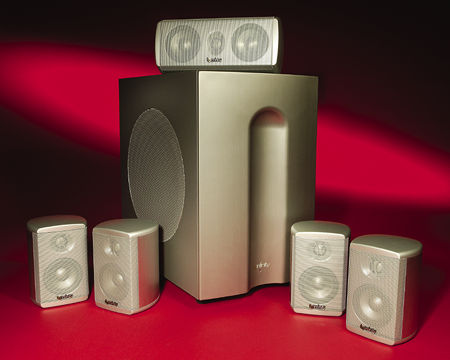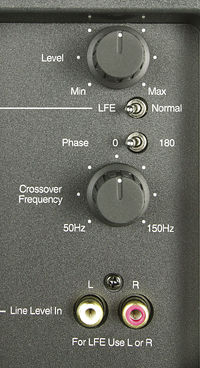Infinity TSS-750 Speaker System
Ah, the life of an audio reviewer is a glamorous one indeed. Lugging around speakers and subwoofers. Continually connecting systems, checking levels, tweaking placement, checking levels again, yada yada yada. Spending hours sitting in a room listening to movie and music tracks that you've watched and listened to so many times, your brain is suffering from burn-in. Yep, with all of this glamour, it might come as a surprise for you to learn that even we audio reviewers fall into the dreaded rut now and then.

The most common audio rut is to bring certain expectations into a review based on a system's appearance and price point. In my case, I review a lot of small, under-$1,000 speaker systems, and I tend to approach each review with a checklist in my head: Is the system bright? Is the subwoofer anemic or boomy? Does it have the dynamics to fill my largish apartment with sound? These are the basic parameters by which I judge each system. Higher-end parameters like precise imaging and the sound's subtle nuances don't often come into play in the entry-level arena. I've certainly never come across a sub-$1,000 system that was too warm or laid-back.
To my delight, Infinity's new TSS-750 speaker system refused to let me slip into my rut. It forced my ears to consider higher-end parameters, and it forced my brain to rethink how I approached this review.
Perhaps that's because Infinity does not treat this new $749 system as a mere afterthought, something that they had to add to their lineup just because everybody's doing it nowadays. Yes, each of the four matching satellites is tiny—measuring just 6 inches high by 4.125 wide by 4.375 deep and weighing a paltry 2.8 pounds—and comes in that brushed-silver finish that's so popular these days (a charcoal finish is also available). Tap your knuckle on that extruded-aluminum enclosure, though, and you won't hear a hollow chamber; the build quality is quite solid. The same is true of the dedicated center channel, which measures just 4.125 inches high by 9.25 wide by 4.375 deep, weighs 4.5 pounds, and comes with a cradle that lets you adjust exactly where you aim the speaker's drivers.
 How about those drivers? No, Infinity's famous CMMD drivers did not trickle all the way down to this system. That probably would be too much to ask, but the company did take the time to design a new driver—and guess what? It's based on the CMMD design. How'd they do it? They just dropped the C. OK, not really. In the new Metal Matrix Diaphragm driver cone, the aluminum core is still covered with a ceramic coating that's anodized on both sides; the coating just isn't as deep as that of the CMMD drivers. The end result is a low-mass, highly rigid driver that's designed to produce a smoother sound with excellent transient response and less distortion and cone breakup. Each satellite incorporates one 0.75-inch MMD tweeter and one 3.5-inch MMD midrange driver, while the center channel adds another 3.5-inch MMD midrange driver.
How about those drivers? No, Infinity's famous CMMD drivers did not trickle all the way down to this system. That probably would be too much to ask, but the company did take the time to design a new driver—and guess what? It's based on the CMMD design. How'd they do it? They just dropped the C. OK, not really. In the new Metal Matrix Diaphragm driver cone, the aluminum core is still covered with a ceramic coating that's anodized on both sides; the coating just isn't as deep as that of the CMMD drivers. The end result is a low-mass, highly rigid driver that's designed to produce a smoother sound with excellent transient response and less distortion and cone breakup. Each satellite incorporates one 0.75-inch MMD tweeter and one 3.5-inch MMD midrange driver, while the center channel adds another 3.5-inch MMD midrange driver.
Clearly, speakers this small are going to need some help in the bass department, and they get that help from a more-sizable powered subwoofer that has a 10-inch woofer and a 150-watt amplifier. It measures 16.75 inches high by 10.75 wide by 15.75 deep and weighs 33 pounds. That's not huge, mind you, but it's a bit larger than average for this price range. The sub's back panel features on/off, phase, and level controls, plus line-level inputs, an adjustable crossover from 50 to 150 hertz, and an LFE/normal switch that serves as a bypass when you want to use your receiver's crossover. Infinity recommends that you set your receiver's crossover to about 120 Hz, and that's good advice, as everything seemed to blend pretty well at that point without much tweaking.
The first half of my review session consisted entirely of film demos. Here, I could embrace my rut, evaluating the TSS-750 as I would any entry-level system. That's not a criticism, as the TSS-750 more than measured up in all of the important categories.
Out of the box, the overall sound was fairly bright, so I let the system get acquainted with our Burmester test CD for a couple of days, after which time the TSS-750 got noticeably warmer. Naturally, its midrange presence was still a bit leaner than what you can expect from a larger speaker, but it did a more-than-respectable job of keeping the sound smooth, never venturing into harsh or grating territory in the higher frequencies.
Those tiny speakers showed impressive dynamic prowess; I could push the volume quite high with no signs of distress. It's a telling sign of the satellites' gusto that it took me a minute to realize that the "Mask" track from the One Giant Leap DVD had defaulted to stereo when I first inserted it; the sound was so full, I naturally thought it was in 5.1—until I realized that the surrounds weren't playing anything (I'm slow, but I catch on).
The center channel produced reasonably full dialogue and other effects, avoiding some of the cupped-hands coloration that plagues many small designs. I found that the center channel had a less direct, in-your-face sound when I aimed the drivers slightly above my head as opposed to directly toward the sweet spot.
The subwoofer showed off its definition with the quick bass notes in "All Together Now" from Yellow Submarine and flexed its low-end muscles in the depth-charge sequence from U-571. No, I'm not talking offensive-lineman muscles here—more like the nice chiseled frame of a wide receiver. It doesn't go super-low, but it's got the aplomb and muscle to complete the big play.
One of my favorite new demo scenes is chapter 12 from The Matrix Reloaded, in which Neo and Seraph engage in a classic kung-fu battle. In addition to all of the quick fighting effects that move around the soundfield, rapid, energetic drums drive the scene forward. The TSS-750 rendered all of the various effects in a taut, believably enveloping way. Fast-forward to chapter 20, and each sword swoosh, metal clank, and crashing statue holds its own in the soundfield, creating an enjoyable demo. The TSS-750 filled my room with the music from Chicago's "Cell Block Tango" sequence without losing each distinct drip of water or tap of a finger in the process.
So far, so good. On to music I went. The demo started out fairly routinely. The TSS-750 handled its duties well, not losing control over the deep bass notes or the high frequencies in Peter Gabriel's challenging, complex "Sky Blue." Track after track, it demonstrated solid workmanship throughout the frequency range, although again the midrange was just a tad lean. Junior Kimbrough's "Junior's Place" off of the Big Bad Love soundtrack is a good test to determine whether a system is bright or just easy on the lower mids. It's an inherently crisp live recording that can sound very sterile and grating through an overly bright system, but that wasn't the case here; I could tell that the satellites were simply reproducing what they were given.
In fact, the TSS-750 seemed to reveal everything, both good and bad, in each track I threw at it. I began to speculate that this system must measure pretty flat. It just had that sense of accuracy and detail that you hear through flatter-measuring speakers. Our measurements chart later confirmed my suspicion. The TSS-750 measures flatter than any entry-level system I've reviewed thus far—and flatter than a lot of more-expensive ones. I happen to be one of those people who'll sacrifice a bit of accuracy for a more-approachable sound, and that approachability is often the result of having a more fleshed-out midrange. Still, I couldn't help but appreciate the dynamics, accuracy, and generally solid blend that the TSS-750 brought to the table.
As the demo went on, my thoughts drifted further away from standard assessments like warmth and dynamics. I found myself noticing how a certain instrument sounded and where it sat within the soundfield, particularly with quieter pieces like Steve Earle's "Goodbye" and Afro-Celt Sound System's "Go on Through." Subtle nuances within a recording began to present themselves. I finally got a faint glimpse of what it must be like when our audio editor Chris Lewis sits down with a $10,000 speaker system. It's those subtle intricacies that can make or break a higher-end system, and the fact that I was even considering such qualities in a $749 sub/sat system was downright amazing.
From the second I heard that Infinity was coming out with a $749 sub/sat system, I knew I had to get my hands on one. (Surprisingly, the TSS-750 isn't even the least expensive system in the new Total Solutions lineup; the TSS-450 costs just $449 but doesn't use the MMD drivers.) I was confident that they would rise to the challenge and produce an entry-level speaker system that looks good, sounds good, and feels good to your wallet. The fact that the TSS-750 lived up to my expectations isn't really surprising; the fact that it redefined those expectations is quite remarkable.

Highlights
• Good build quality
• Smooth highs and lows
• Its performance far surpasses its $749 price tag























































